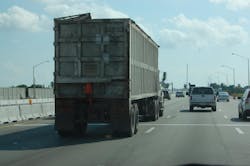“Downspeeding” is a rather clunky description of what’s becoming a significant vehicle engineering tactic for boosting fuel economy – a tactic Volvo Trucks of North America, for example, touted three years ago and continues to believe will continue to save fleets diesel and dollars both down the road (no pun intended).
At its heart, “downspeeding” is about making diesel engines operate at low speeds with high torque – thus resulting in higher efficiency with reduced fuel consumption, due to reduced engine friction from low piston speeds, reduced relative heat transfer and increased thermodynamic efficiency.Andy Nieman (at right), VP-global engineering for Dana Commercial Vehicle Technologies, dug more deeply into this topic in a recent white paper so as to help fleets not only get a better handle on the “downspeeding” concept but understand why this engineering tactic is expected to become more widely used.
“New U.S. fuel economy standards are coming for commercial vehicles, and your fleet will look much different as a result,” he explained, as the Environmental Protection Agency (EPA) and the Department of Transportation (DOT) are creating new fuel economy and greenhouse gas standards for medium-duty and heavy-duty vehicles that will be finalized and issued by March 2016.
That’s putting pressure on truck manufacturers to accelerate efforts to squeeze more miles out of every gallon of diesel consumed by their products.
“Every vehicle system is ripe for scrutiny, but the primary target is the engine, which is responsible for up to 60% of all energy losses on any given linehaul truck,” Nieman noted.
“Yet modifications to the engine, however, can carry substantial risks,” he warned. “So how can we make the engine more efficient without giving up a single horsepower of performance when we need it? These days, the answer is engine downspeeding.”
Instead of reducing the physical size of the engine, he said the focus instead is on reducing the revolutions per minute or “RPMs” generated by engine operation, especially at highway speeds between 61 and 68 miles per hour (mph).“Downspeeding allows the engine to cruise in its ‘sweet spot,’ reducing friction and increasing fuel efficiency,” Nieman stressed.
“Thus where most truck engines today run at around 1450 RPM at cruising speed to provide the 200 horsepower (HP) needed at the wheel end, engine downspeeding allows the truck to operate consistently in a more efficient range, generally between 1100 to 1200 RPM, while maintaining the same 200 HP at the wheel end,” he said.
And, as a result, fuel efficiency increases substantially since the engine isn’t working as hard to maintain vehicle speed, he pointed out.
“Fuel efficiency increases by approximately 1% for every 100 RPM reduction at highway cruise speeds, and the savings are even more impressive for light loads or empty returns,” Nieman emphasized.
“Current technology allows downspeeding engines to reduce fuel consumption by about 550 gallons per truck annually,” he added. “Translated into dollars and cents, this increased efficiency delivers a fuel savings of nearly $2,200 per truck every year.”Of course, as with most engineering efforts like this, Sir Isaac Newton’s “Third Law of Motion,” which states that for every action, there is an equal and opposite reaction, gets involved.
(You remember Sir Isaac, right? The dude who figured out physics after watching an apple fall from a tree? Some apple that!)
In the case of downspeeding, Nieman said that engine’s operating at lower RPMs generate significantly higher torque stresses upon drivetrain components. For example, by dropping from 1450 RPM to 1125 RPM, torque loads in the driveline increase by 57% – placing greater stress on axles, the driveshaft, and the inter-axle shaft, potentially reducing the life of these components, especially U-joints.
Of course, Dana thinks some of its products can help out in this area, and Nieman delves into some of the tactics that can applied to mitigate the impact of the higher torque loads generated by downspeeding efforts.
At the end of the day, though, the key point to remember is this: OEMs must comply with new fuel efficiency mandates that are due to arrive in a little more than a year. Downspeeding is one method some of them – if not many of them – plan to use to meet those new rules.
Thus it behooves fleets to start studying up on downspeeding both to figure out how to maximize the advantages offered by this new engineering tactic – especially in terms of fuel savings – while minimizing any pitfalls.



